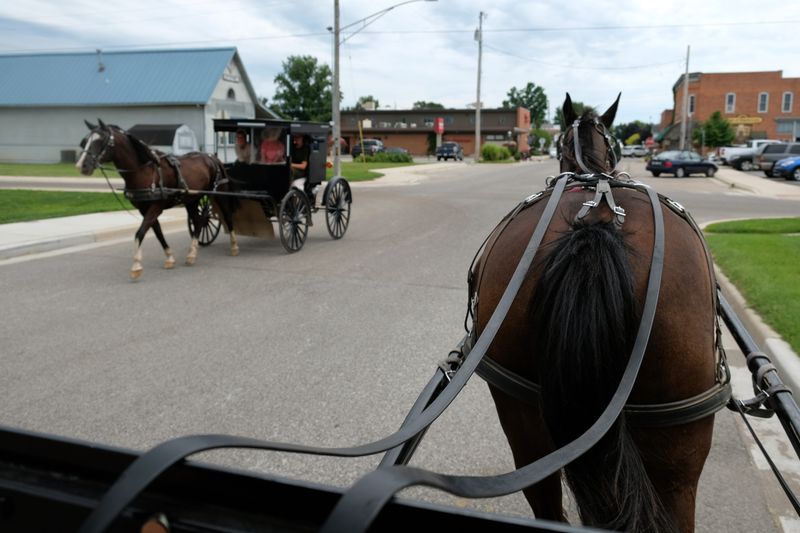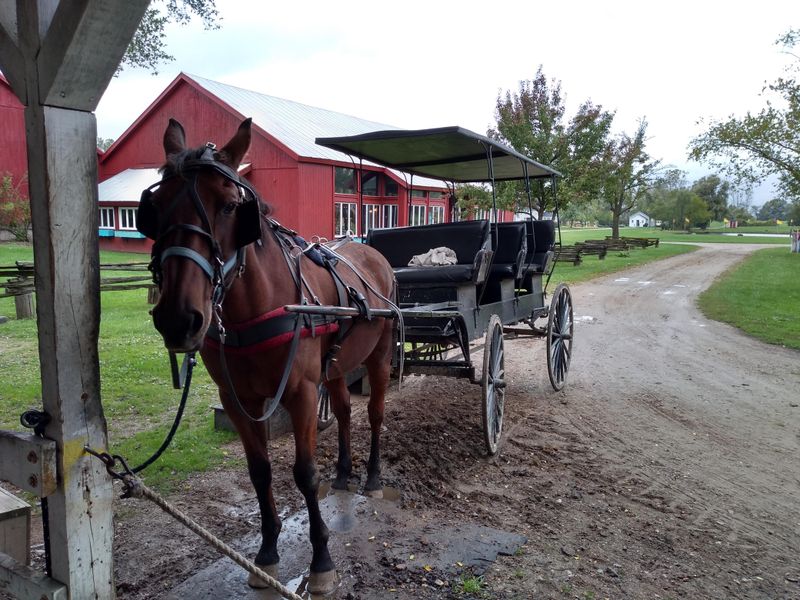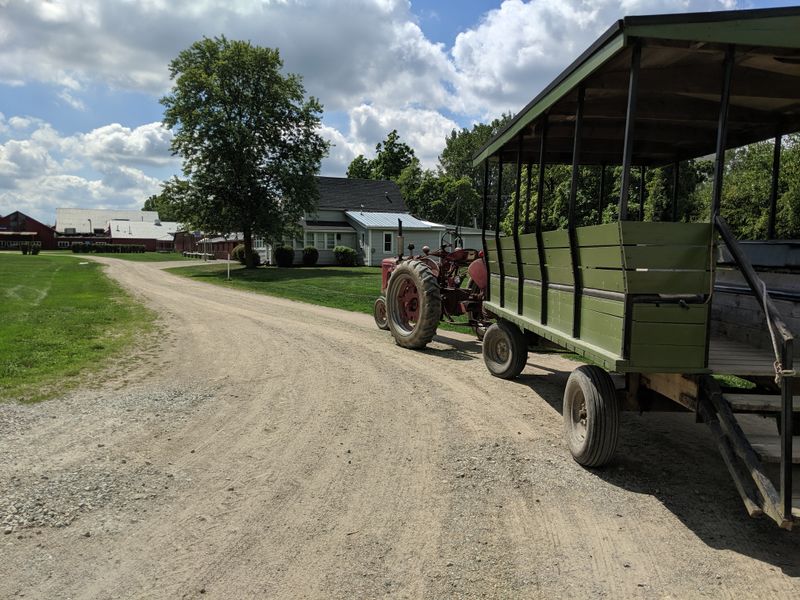Indiana’s Amish villages offer a peaceful glimpse into a simpler way of life, but many travelers unknowingly cross important boundaries.
These tight-knit communities welcome respectful visitors, yet certain behaviors can offend or disrupt their daily routines.
Understanding the unspoken rules helps protect both the culture and your experience.
From photography mishaps to inappropriate clothing choices, tourists often stumble without realizing the impact.
Learning these lessons transforms you from an accidental intruder into a thoughtful guest who truly appreciates this unique destination.
Snapping Photos Without Permission

Most visitors don’t realize that taking pictures of Amish people violates their deeply held religious beliefs.
The Amish interpret the biblical commandment against graven images to include photographs, which they believe can foster vanity and pride.
When you point a camera at someone in traditional dress, you’re not just being rude.
You’re asking them to compromise their faith.
Many tourists assume that snapping a quick photo from across the street is harmless, but Amish community members can feel uncomfortable and disrespected.
Children playing in yards or families traveling in buggies deserve the same privacy you’d want for your own family.
Instead of focusing your lens on people, capture the beautiful landscapes, barns, and quilts displayed for sale.
These images tell the story of Amish craftsmanship without crossing personal boundaries.
Ask permission before photographing anyone, and graciously accept if they decline.
Treating Buggies Like Tourist Attractions

Horse-drawn buggies aren’t props for your vacation scrapbook.
They’re the primary transportation for families heading to work, church, or the grocery store.
Tailgating these slow-moving vehicles or honking impatiently creates dangerous situations for both the horse and passengers.
Buggies travel at about ten miles per hour, and sudden loud noises can startle the horses.
A spooked animal might bolt into traffic or veer off the road, risking serious injury.
Tourists who don’t understand this often follow too closely, trying to get the perfect shot through their windshield.
When you encounter a buggy, slow down and wait for a safe passing zone with clear visibility.
Give them plenty of space, just as you would a bicycle or motorcycle.
Remember that the orange triangle on the back isn’t decorative.
It’s a safety requirement because these families share the roads with much faster vehicles every single day.
Wearing Inappropriate Clothing

Showing up in revealing summer outfits sends the wrong message in Amish communities.
These families follow strict modesty standards, with women wearing long dresses and men in plain shirts and trousers.
Your beach shorts and tank top might feel comfortable, but they can make your hosts uncomfortable in their own neighborhood.
Visitors sometimes argue that they shouldn’t have to change their style for a day trip.
However, dressing respectfully isn’t about changing who you are.
It’s about showing consideration for people who’ve welcomed you into their world.
Modest clothing doesn’t mean boring.
Simple pants or knee-length skirts with covered shoulders work perfectly fine.
Think of it like visiting a religious building where certain attire is expected.
The Amish don’t demand you wear their traditional clothing, but they do appreciate when guests avoid extremes.
Pack an extra layer or longer bottoms if you’re planning to visit shops, workshops, or restaurants in these areas.
Shopping Without Buying Anything

Browsing is fine, but some tourists treat Amish shops like free museums.
They spend an hour examining handmade furniture, asking detailed questions, then leave without purchasing even a small item.
These aren’t hobby businesses.
They’re how families earn their living and support their communities.
Craftspeople pour hours into each quilt, piece of furniture, or baked good.
When you engage their time and expertise but buy nothing, it can feel disrespectful.
Many Amish vendors are too polite to express frustration, but they notice the pattern of lookers versus buyers.
If you’re genuinely interested but can’t afford larger items, consider purchasing something small like homemade jam, fresh bread, or a simple wooden toy.
These affordable options still support the family and show you value their work.
If you’re truly just looking, keep your visit brief and be honest about your intentions upfront so they can focus on serious customers.
Asking Invasive Personal Questions

Curiosity is natural, but bombarding Amish shopkeepers with personal questions crosses a line.
Asking about their bathroom habits, bedroom practices, or why they don’t use electricity puts them in an awkward position.
They’re trying to run a business, not provide anthropology lessons to every curious visitor.
Some tourists seem to forget they’re talking to real people with feelings and boundaries.
Questions like “Do you really not watch TV?” or “What happens if you break the rules?” can feel intrusive and judgmental.
The Amish are accustomed to interest in their lifestyle, but there’s a difference between respectful curiosity and treating someone like an exhibit.
Stick to questions about the products they’re selling or general information they volunteer.
If you’re genuinely interested in Amish culture, visit a heritage center or read a book written for that purpose.
Let business interactions focus on the beautiful items they’ve created rather than turning every transaction into an uncomfortable interview.
Driving Too Fast on Rural Roads

Speeding through Amish country isn’t just illegal. It’s dangerous for everyone sharing those narrow roads.
Children walk to school, families travel in buggies, and farmers move equipment between fields. Your hurry could cost someone their life.
Many accidents happen because drivers unfamiliar with the area don’t anticipate slow-moving vehicles around blind curves.
The scenic backroads that make these communities charming also create visibility challenges.
A buggy can appear suddenly over a hill or around a bend, leaving little time to react if you’re going too fast.
Posted speed limits in these areas account for mixed traffic, so follow them carefully.
Watch for buggy crossing signs and slow-moving vehicle warnings.
If you’re running late, leave earlier next time rather than risking tragedy.
The relaxed pace is part of what makes visiting Amish villages special, so embrace the slower rhythm instead of fighting against it.
Your destination will still be there when you arrive safely.
Visiting on Sundays

Sunday is the Amish Sabbath, a sacred day reserved for worship, family, and rest.
Shops close, markets shut down, and families gather for church services that rotate between homes.
Tourists who show up expecting to browse or buy are met with locked doors and understandable frustration from residents.
Some visitors take offense when they find nothing open, not realizing they’ve chosen the one day the community deliberately sets aside.
Others wander residential areas looking for activity, which intrudes on private family time.
Imagine strangers driving slowly past your house during a holiday dinner, and you’ll understand how it feels.
Plan your visit for Monday through Saturday when businesses welcome customers and artisans are available to discuss their work.
If you accidentally arrive on Sunday, respect the closed signs and use the time to enjoy the peaceful countryside scenery instead.
The quiet roads and empty fields offer their own kind of beauty, reminding us that rest matters in our busy modern lives.
Expecting Modern Conveniences

Complaining about the lack of air conditioning, credit card machines, or public restrooms misses the entire point of visiting Amish communities.
These families have deliberately chosen a simpler lifestyle that rejects many modern conveniences.
Your comfort preferences don’t override their values.
Some tourists get frustrated when they can’t charge their phones or find wireless internet in Amish-owned establishments.
Others grumble about cash-only policies or the absence of public facilities. These reactions show a lack of preparation and understanding.
You’re visiting a community that functions differently, not a theme park designed around your expectations.
Bring cash, use the restroom before you arrive, and dress for the weather since most shops rely on natural ventilation.
If you need constant connectivity and modern amenities, Amish villages probably aren’t the right destination for you.
Part of the experience involves stepping away from the digital world and appreciating a lifestyle built on different priorities.
Embrace the simplicity instead of resisting it.
Blocking Driveways and Farm Lanes

Parking wherever you spot a good photo opportunity creates real problems for working farms.
Tourists block driveways, farm lanes, and field entrances without thinking about the families who need access.
A blocked driveway isn’t just inconvenient. It can prevent farmers from reaching livestock, moving equipment, or responding to emergencies.
Many visitors assume that because the roads are quiet, parking on the shoulder near someone’s property is harmless.
However, these are active farms and homes, not public parks.
Your car might prevent a family from getting their buggy out or block a tractor that needs to reach a field for time-sensitive work.
Look for designated parking areas near shops and public spaces.
If you want to stop for photos, find a safe pullout that doesn’t obstruct private property.
When in doubt, keep driving until you find an appropriate spot.
The Amish are generally patient with visitors, but blocking their access to their own property tests that patience unfairly.
Ignoring Local Business Hours

Arriving after closing time and knocking on doors or peering in windows is disrespectful.
Many Amish businesses operate from homes or properties where families live, so the shop’s closing time marks the beginning of private family time.
Persistent tourists who ignore posted hours essentially intrude on someone’s home.
Some visitors assume that small, family-run businesses might make exceptions or stay open late for one more customer.
This attitude fails to recognize that Amish families balance work with numerous other responsibilities including large households, farm chores, and community obligations.
Their time matters just as much as yours.
Check business hours before you visit, and plan your route accordingly.
If you arrive to find a shop closed, respect the decision and return during operating hours.
Many Amish businesses keep shorter or seasonal hours, so calling ahead (some have phone shanties for business calls) can save disappointment.
Treating their schedule with respect shows you value them as people, not just as a tourist attraction to be consumed on your timetable.
Dear Reader: This page may contain affiliate links which may earn a commission if you click through and make a purchase. Our independent journalism is not influenced by any advertiser or commercial initiative unless it is clearly marked as sponsored content. As travel products change, please be sure to reconfirm all details and stay up to date with current events to ensure a safe and successful trip.